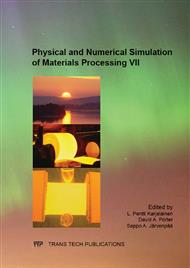[3]
where a = b2(G-1)/2, b is an empirical coefficient, G is the ASTM grain size, D is an effective diffusion coefficient, ΔT is the undercooling, and q is an exponent dependent on the diffusion mechanism. Once the TTT diagram is calculated, the CCT diagram can be obtained using well-established additivity rules [20]. Such calculation can be performed with good accuracy for steels over a wide composition, including medium to high alloy types, tool steels and stainless steels [[] N. Saunders, Z. Guo, X. Li, A.P. Miodownik and J.P. Schillé: The calculation of TTT and CCT diagrams for general steels, Internal report, Sente Software Ltd., U.K., 2004. ]. Phase transformation model II – Johnson-Mehl-Avrami-Kolmogorov model. This type of model has been employed to studied transformations such as the precipitation of secondary phases in stainless steels [[] X. Li, A.P. Miodownik and N. Saunders: Mater.Sci. Technol., Vol. 18 (2002), p.861
Google Scholar
[4]
where X is the volume fraction of the product phase, Vf is the volume transformed, Veq(T) is the equilibrium volume amount of the phase at temperature T, f is a shape factor, Nr is the nucleation rate, Gr is the growth rate and t is time. For the case where site saturation occurs, one has [22]:
Google Scholar
[5]
where No is the total number of active nucleant sites. The method for calculating Nr and Gr has been described in Ref. 22. Microstructure-Property Relationships. Whether microstructure-property relationship should be called material models remains debatable. It is nonetheless listed separately here to highlight its importance, as this is where various structural length scales (dislocations, particles, grains, etc.) are naturally covered, therefore playing a critical role in successful realisation of multiscale modelling [[] M.F. Horstemeyer: Integrated Computational Materials Engineering for Metals - Using Multiscale Modeling to Invigorate Engineering Design with Science, (Wiley-TMS, 2012). ]. Simulation of heat transfer requires the knowledge of thermal conductivity and heat capacity, and deformation simulation requires elastic modulus, Poisson's ratio, thermal expansion coefficient, strength and flow stress curves. Now that phase transformation kinetics gives microstructure at certain processing treatments, microstructure-property models are needed to calculate the required material properties, all of which are a function of temperature and/or strain rate. For each individual phase in a multi-component system, properties, such as molar volume, thermal conductivity, Young's modulus, and Poisson's ratio, are calculated using simple pair-wise mixture models [[] X. Li, A.P. Miodownik and N. Saunders: J. Phase Equilibria, Vol.22 (2001) pp.247-253
Google Scholar
[6]
where P is the property of the phase, Pi0 is the property of the phase in the pure element, Ωijv is a binary interaction parameter dependent on the value of v, xi and xj are the mole fractions of elements i and j in the phase. Both Pi0 and Ωijv are temperature dependent and it is possible to include ternary or higher order effects where appropriate. Once the property of each individual phase is defined, finally, the property of the alloy can be calculated via appropriate mixture models [[] Z. Fan, P. Tsakiropoulos, A.P. Miodownik, J. Mat. Sci. Vol. 29 (1994) p.141
Google Scholar


